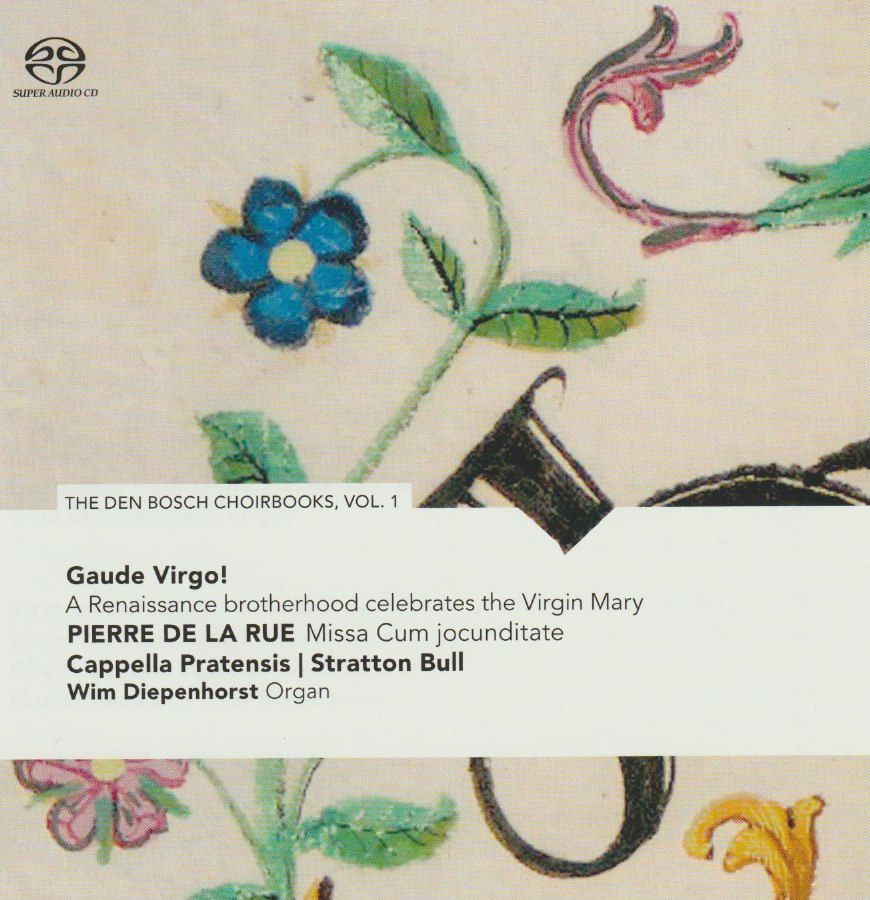Gaude Virgo!: Cappella Pratensis (2)
A stunning recording launching a valuable project

“
We previously considered both a live concert in France and another of Cappella Pratensis' discs here. That disc celebrated John teh Evangelist: here we have “a Renaissance brotehrhood celebrates theVirgin Mary”. Once more Capella Pratensis is directed by one of its members, Stratton Bull; the organist is Wim Diepernhorst.
Here is the perfect place to explore the background to these recordings. Right at the dawn of the Renaissance, the the southern Dutch city of 's Herogenbosch . At the centre of the city's cultural activities was the Brotherhood of Our Illustrious Lady (“Illustre Lieve Vrouwe Broederschap”), founded in 1318; and included in its fraternity was one Heironymus Bosch. There eare nine choirbooks extant from this Brotherhood (includiing three manuscripts from the Alamire workshopo, famous for its luxurious manuscripts); the polyphonic sources are complemented by plainchant sources.
Capella Pratenses is itself based in 's Herogenbosch: this is the first fruit of a five-year project that will include concerts, workshops, digitisation ofthe manuscripts and, of course, CDs and appears thanks to a close collaboration with the Alamire Foundation, International Centre for the Study of Music in the Low Countries (University of Leuven).
The Brotherhood in 's-Hertogenbosch was a Maria Brotherhood, and therefore had links with the Mother Mary - and thereby celebrates the Divine Finine in teh Christian stream of religious thought. While the vast bilk of the disc is a performance, with plainchant and organ improvisations, of the de la Rue Missa Cum jocunditate, the disc closes with Pierre de la Rue's glorious motet, Gaude Virgo, from which the disc takes its name. It is a joyous setting of a poem that enmerates the Seven Joys of Mary. Every single verse begins with the word “Gaude” (Rejoice), and the performance is absolutely radiant, the lines perfectly clean (even when it is several lower voices alone):
There is reasoning behind this placement: every mass in the Alamire choirbooks has an appended motet.
The Missa itself is based on the first six notes of the final Vespers antophon for the feast of the Nativity of the Blessed Virgin (in the Kyrie and Gloria, the tenor repeats these notes almost exclusively). The text is celebratory (Cum jocunditate = With Joy). Her eis the Kyrie:
The key to appreciating how this disc works is a straight-through listen, so one can hear how, for example, the to Plainchants, the Graduale “Benedicte et venerabilis es” and the Alleluia ”Ave Maria,” plus the organ improvisation on the anonymous ”Verbum bonum et suave” The Alleluia plainchant is stunningly beautiful, and seques into this miraculous improvisation by Wim Diepenhorst, followed by the Anonymous motet on the same (“Verbum bonum”) - both are in the same video:
The solo organ pieces are played on the Swallow's Nest organ (definition) in the Marienkirche, Germany. See here for an article about the organ with photos that clearly show why “Swallow's Nest” is fully appropriate! (NB although the journal is called Het Orgel, the article is in English).
Pierre de la Rue's setting of the Credo is fascinating. This mass being of Marian bent, it was the lines
Et incarnatus est de Spiritu Sancto
ex Maria virginæ:
et homo factus est
(“And was incarnate by the Holy Spirit / from the Virgin Mary, / and was made man”)
that seem to be of most importance. Certainly the setting changes from beautifully, intriccatey florid to suddenly homophonic (chordal) before blossoming out aain as if teh subject itself demands such exuberance; and note the swing of mood when the text deals with the crcifixion under Pontius Pilate:
For me, Diepenhorst's iprovisations play a vital part inthe process - fresh, vital, properly off-the-cuff, they come with unbiult joy, as the short (1’33) improvisation on “O salutaris hostia” shows:
Thsi improvisation marks the beginnig of the Eucharist, follwed by a six-voice anonymous motet, Sub tuum presidum. The wlwment of ritual in thsi service is foregrounded in the Sanctus, the music that accompanied the Elevation of the Host. Listen to how the tenor line repeats the “Cum jocunditate” motif in a descending sequence (the booklet notes explain this in detail - the notation de la Rue used is fascinating) untiul the words “Pleni sunt celi et terra gloris tua” (Heaven and earth are full of your glory). The Elevation istelf is via the motet “O salutaris hostia,” included at the end of this track:
As for the recording: it is simply fabulous, a Super Audio Compact Disc with surround sound (playable in two-channel players, of course). The sound via Apple Music through iPods Max headphones (and therefore making the best of the Lossless format) is stunning - the reverberation is so realistic one really could be in the Church of Franc-Warêt in Belgium (the actual recording venue for the choral music, incidentally!).
